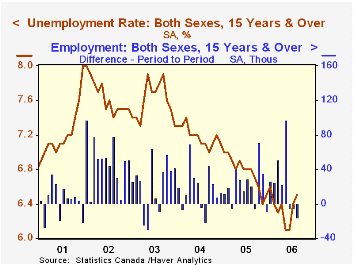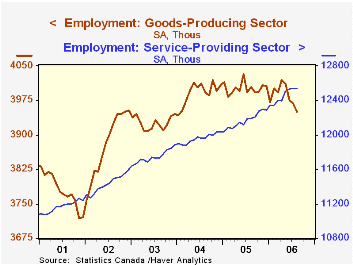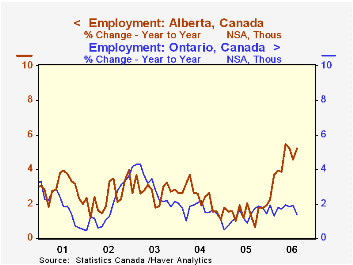 Global| Sep 08 2006
Global| Sep 08 2006Canada Labor Market Pause into 3rd Month
Summary
In August, Canadian labor markets extended into a third month their correction of the May employment spike, as shown in StatCan data reported this morning. Employment fell by 16,000 in August, after two consecutive decreases of 5,000. [...]

In August, Canadian labor markets extended into a third month their correction of the May employment spike, as shown in StatCan data reported this morning. Employment fell by 16,000 in August, after two consecutive decreases of 5,000. These followed a spurt of 97,000 in May. The unemployment rate ticked up from 6.4% in July to 6.5% last month, while participation in the labor force reverted from 67.3% of the total labor force to 67.2% (All these data cover the population 15 and over; participation for the "working age" population, ages 15-64, is 77.9%).
A month ago, we tried to "explain away" the employment decline and bump-up in unemployment as mere corrections to the huge gains in May. Extending this interpretation to a third month may seem to be reaching or trying to evade some hint of genuine slowdown. However, the fact remains that the recent relative weakness in employment is coming in the industries that spiked the most in May: finance, insurance & real estate; health care; and public administration. The finance and real estate sector is surely cyclical and subject to buffeting by market forces, but health care and government are not. Health care, though, seems to have become more volatile in the last couple of years, making it hard to draw any substantive conclusion.
What we do see in Canada fairly unequivocally, though, is a major downward thrust in goods-producing industries. Back at the turn of the year, it looked that manufacturing might be trying to stabilize, but this was short-lived, and by May it was falling once again. Other industries in that sector -- agriculture, construction, etc. -- did show increases through the end of 2005, but they have flattened since, even the forestry and mining group, which now has 1,500 fewer workers than in December 2005. It had gained more than 25,000 over last year, but apparently the oil-price inspired build-up has faded. Provincial data seem to confirm that, showing a plateau in employment in energy-rich Alberta, British Columbia and Saskatchewan; the number of workers is falling gently from month to month in the business centers of Ontario and Quebec and contracting more definitively in the Maritimes.
Canada's nationwide data are contained in Haver's CANSIM database, and the Provinces are covered in CANSIMR.
| Canada (Seasonally Adjusted) | Aug 2006 | Jul 2006 | June 2006 | May 2006 | Year Ago | 2005 | 2004 | 2003 |
|---|---|---|---|---|---|---|---|---|
| Employment (000s) | 16,489 | 16,505 | 16,510 | 16,515 | 16,201 | 16,170 | 15,947 | 15,672 |
| Change, 000s/% | -16 | -5 | -5 | +97 | 1.7% | 1.4% | 1.8% | 2.4% |
| Goods-Producing | -18 | -7 | -35 | -10 | -1.4% | 0.2% | 1.7% | 1.2% |
| Service-Producing | +2 | +2 | +30 | +106 | 2.8% | 2.1% | 1.8% | 2.7% |
| Unemployment (000s) | 1,141 | 1,137 | 1,067 | 1,073 | 1,178 | 1,173 | 1,235 | 1,286 |
| Unemployment Rate (%) | 6.5 | 6.4 | 6.1 | 6.1 | 6.8 | 6.8 | 7.2 | 7.6 |
| Participation Rate (%) | 67.2 | 67.3 | 67.2 | 67.3 | 67.2 | 67.2 | 67.5 | 67.5 |
Carol Stone, CBE
AuthorMore in Author Profile »Carol Stone, CBE came to Haver Analytics in 2003 following more than 35 years as a financial market economist at major Wall Street financial institutions, most especially Merrill Lynch and Nomura Securities. She had broad experience in analysis and forecasting of flow-of-funds accounts, the federal budget and Federal Reserve operations. At Nomura Securities, among other duties, she developed various indicator forecasting tools and edited a daily global publication produced in London and New York for readers in Tokyo. At Haver Analytics, Carol was a member of the Research Department, aiding database managers with research and documentation efforts, as well as posting commentary on select economic reports. In addition, she conducted Ways-of-the-World, a blog on economic issues for an Episcopal-Church-affiliated website, The Geranium Farm. During her career, Carol served as an officer of the Money Marketeers and the Downtown Economists Club. She had a PhD from NYU's Stern School of Business. She lived in Brooklyn, New York, and had a weekend home on Long Island.





